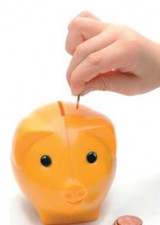Sue Cowley shares four ways to put pupils in a positive frame of mind for learning...
 1. Money box magic
1. Money box magic
This is a great starter for developing listening and thinking skills, as well as for practising counting, addition and times tables.
• You will need a tin or china money box (you need the coins to make a clear clinking sound when they drop in) and sets of coins – five or 10 coins each of 1p, 2p, 5p, 10p etc.
• Show the children the money box and explain that you are going to be dropping some coins in.
• The challenge is to work out how much money you ‘save’ each time.
• But there’s a catch. You are going to turn round to drop the coins into the money box, so that the children can’t see.
• The pupils must listen to hear how many coins you drop in. They must then work out how much money there is in total.
• Start with 1p and work upwards so that the children have to do some mental addition or use their times tables.
• Ask for some volunteers to have a go.
 2. All in a Line
2. All in a Line
This activity encourages your children to work together and cooperate while they practise number order.
• You will need a set of sticky notes. Write numbers on these, e.g. 1–10, 1–20, 1–30, odd numbers, even numbers, number sequences.
• Explain to the pupils that the challenge is to line up for a bus – but they must line up in the correct order.
• They do not get to see their number, but they can see everyone else’s. However, the rule is that they are not allowed to tell anyone else what their number is, and they cannot tell anyone else where to stand in the line.
• Get the children to form a line and put a sticky note on each pupil – this can go either on their backs, or on their foreheads if they don’t mind!
• When you say “go”, the pupils must work out how to line up in the correct order. For instance, they might ask someone “Is my number smaller or bigger than 5?” or “Tell me a sum where my number is the answer”.
 3. Who wants to be a maths champ?
3. Who wants to be a maths champ?
This fun mental maths activity uses the format of the popular TV programme, Who Wants to be a Millionaire?
• Start with a round of ‘fastest brain first’. Pose a maths question to the class. The first pupil to put their hand up and give a correct answer gets to be in the hot seat.
• If possible, use a ‘special’ chair (e.g. a bar stool) to give more authenticity to the activity.
• The pupil now has to answer a series of tricky maths questions as quickly as possible. You could use a timer or a countdown clock on your interactive whiteboard to up the tension. Warn the pupil that you will take his or her first answer.
• The rest of the class should also think about what answer they would give to each question.
• The contestant has two lifelines: ‘ask the audience’, where the rest of the class give their answers, and ‘phone a friend’ where they can ask one individual.
• If a wrong answer is given, the game starts over again.
 4. Twister!
4. Twister!
This activity is based on the hilarious game of Twister and is great for quick-fire mental maths.
• Prepare several Twister mats by sticking together A4 sheets of paper, each with a set of numbers on them. Depending on the area of maths you want to practise, this might be 1–20, 10–200 in tens, multiples of four, and so on.
• Divide the class into groups of around four children, with each group having a Twister mat.
• The groups must now run their game of Twister, with one person posing a maths question and the other pupils playing the game.
• For instance, “Sophie, put your right hand on the answer to 4x5, Sanjay put your nose on the missing number in this equation: 10 minus X = 3”.
Visit http://www.suecowley.co.uk for more ideas.
How To Use Books To Help Children Cope With Life
Ace-English
How to be a singing school
Ace-Music
